|
|
|
SANDER (Max)
Le Livre ? Figures Italien depuis 1467 jusqu'a 1530. Essai de sa Bibliographie et de son Histoire. [With:] RAVA (Carlo Enrico) Supplement...
7 Vols., in 6, 4to, limited to 350 numbered copies, numerous facsimiles throughout (some coloured), orig. cloth. Sander's important study of the development and progress of the graphic arts in Italian book illustration. This fundamental reference book (text in French) contains the descriptions of over 8,000 works. Each listing includes a precise collation, bibliographical citations, sale prices and, in many cases, notes on the edition and descriptions of particularly significant illustrations.
|
|
|
SARRIA, Amalia.
Les Rois Bibliophiles.- Catalogue d'exposition par Amalia Sarria avec la collaboration de Claudine Lemaire. Traduit de l'Espagnol par Therese Glorieux-de Gand. Avant-propos de Martin Wittek.
Bruxelles, Bibliotheque Royale Albert 1er, 1985. in-4°, 224 pages, abdt ill.en n&b et en couleurs, bibliographie, index, broche, couverture carton souple illustree à rabats.- Catalogue d'exposition organisEe dans le cadre d'Europalia 85 Espagne.
Référence libraire : 20006
|
|
|
SARRIA, Amalia.
Les Rois Bibliophiles.- Catalogue d'exposition par Amalia Sarria avec la collaboration de Claudine Lemaire. Traduit de l'Espagnol par Therese Glorieux-de Gand. Avant-propos de Martin Wittek.
in-4°, 224 pages, abdt ill.en n&b et en couleurs, bibliographie, index, broche, couverture carton souple illustree à rabats.- Catalogue d'exposition organisEe dans le cadre d'Europalia 85 Espagne. Bel exemplaire. [PLC-3][HP-3] Contient : La Science arabe dans les collections de l'Escurial par Hosam Elkhadem.
|
|
|
Schöne Miniaturen
Schöne Miniaturen aus Handschriften in Schweizerischen Bibliotheken, Band 1. hrsg. von Jos Schmid.
Luzern, Schweizerischen Bibliophilen Gesellschaft. 1941; in-4, en feuilles, cartonnage à rabats, reproductions en noir et en couleurs. Un des 250 exemplaires numérotés.
Référence libraire : 2377
|
|
|
SCH?FER (Otto)
Katalog der Bibliothek Otto Sch?fer Schweinfurt. Edited by Manfred von Arnim. 1 Drucke, Manuskripte und Einb?nde des 15. Jahrhunderts.
2 Parts, 4to, 420;396pp., one of 800 copies, 168 illustrs., (28 coloured), orig. cloth, gilt, slip-case. "The Sch?fer Library is one of the largest and finest private collections in Europe!... a great catalogue of a great collection... an essential tool for any incunabulist and for students of early illustrated books..." - from a review.
|
|
|
SCHULLIAN (Dorothy M.) & SOMMER (Francis E.)
A Catalogue of Incunabula and Manuscripts in the Army Medical Library.
First Edition, large 8vo, xiv,361pp.,12 plates, orig. cloth. Describes some 662 items in detail (525 of which are books).
|
|
|
Selves, Henry-Antoine-Auguste imprimeur- lithographe
Atlas Geographique, Dressé Sous La Direction Du Conseil Royal De L'Instuction Publique, Pour L'usage Des Colleges. Ouvrage Adopté Pour L'Enseignement Public.comprenant les trois parties suivantes : géographie ancienne, du moyen age et géographie moderne actuelle
1822 Imprimerie de Selves fils, Litographie de l'Université, Rue des Lions St. Paul, n°14, A Paris, Selves 1822, in8 reliure cartonnée époque leg.défraichie,42 cartes doubles coloriées en lithographie sur onglet, liste collée sur le premier plat, trés rare incunable de la lithographie.
Référence libraire : 24813
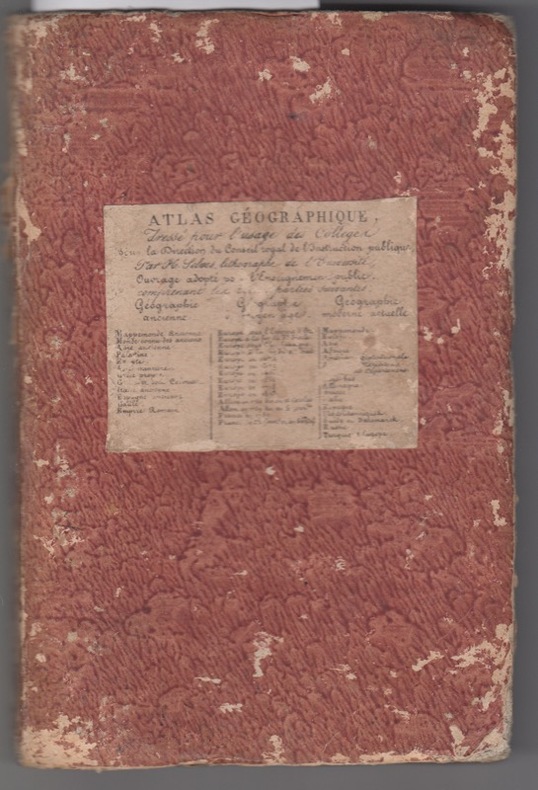
|
|
|
SERNA SANTANDER (Carlos Antonio de la)
M?moire sur l'Origine et le Premier Usage des Signatures et des Chiffres, dans l'Art Typographique.
8vo, 30, [2 blank]pp., lightly waterstained throughout, orig. drab paper wrappers, bound in patterned paper boards. First edition of a fascinating early monograph on printed signatures, foliation, registers and catch-words in 15th-century books. It is dedicated to the great Belgian collector Charles van Hulthem. Count Serna, who is here given the timely title of "Citoyen", was an important incunabulist and printing historian. He correctly attributes the first use of signatures to Johann Koelhoff the elder in Nider's Praeceptorium 1472, and of foliation to Arnold Ther Hoernen in Adrianus Carthusiensis' De remediis utriusque fortunae 1471. He agrees with Marolles (Recherches sur l'origine et le premier usage des registres 1783) that Sweynheym and Pannartz were the first printers to employ a register [the table in the 1469 Caesar], but it is now thought that the anonymous Hieronymus' Epistolae [Rome: probably Sixtus Riessinger, c. 1468--69] may be the first book to have been issued with one. The author rightly identifies Vindelinus de Spira (and not his brother Johannes) as the printer of Tacitus' Opera [now assigned a somewhat later date than Haebler's 1471], the first printed book with catch-words. Provenance: Bookplate of A. W. Barten. Bigmore & Wyman II, 352.
|
|
|
SILVESTRE Armand & MORAND Eugene
GRISELIDIS, Mystere - Gouaches. Aquarelles. Lettres ornees & ecriture par Serge Beaune
1920, En feuilles (232 x 250 mm) sous un portefeuille. 153 feuillets.Sur japon nacre, chaque feuillet manuscrit recto verso est execute sur papier japon nacre a fort grammage et se compose d’un texte manuscrit a l’imitation de l’ancien encadre de compositions art nouveau, bandeaux, culs de lampes et motifs.Les motifs decoratifs a theme animalier ou abstrait, pour certains s’inspirent de l’art roman, d’autres de themes egyptiens et orientaux.Bien qu’uniforme dans l’esprit les themes changent subtilement d’une page a l’autre en changeant de couleurs d’une scene a l’autre. Chaque initiale du texte et le nom des personnages est peint en rouge.Chaque scene (en moyenne toutes les deux et trois pages, parfois moins) s’ouvre par une peinture occupant la moitie de l’espace dans une demi ogive, realisee a la gouache puis vernie.Les ornements etant peints dans une technique mixte gouache et aquarelle.La tonalite de l’ouvrage joue sur les clairs obscurs et privilegie les scenes de nuit ou d’interieurs eclairees par des lanternes et flambeaux.Ces scenes alternent des paysages crepusculaires.Ouvrage date et signe en fin d’ouvrage « Termine le 23 mars 1920, Serge Beaune »
Référence libraire : 3001
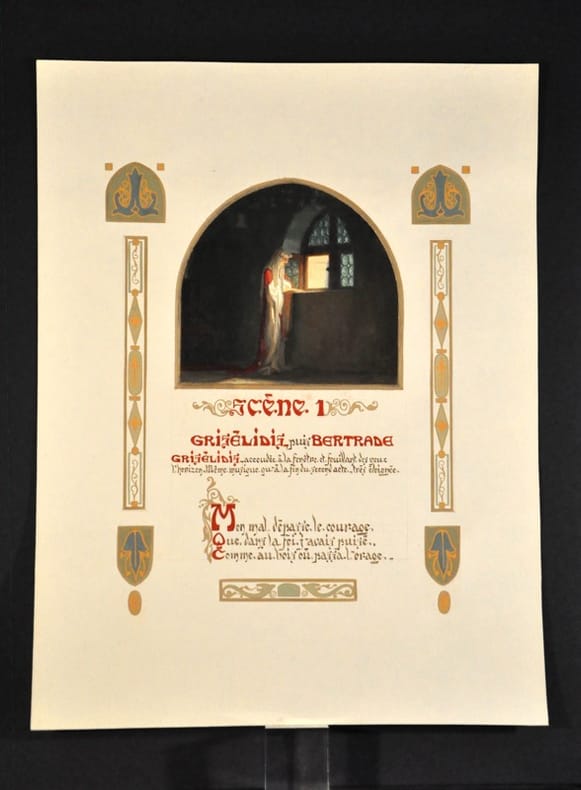
|
|
|
SNEYD (Colonel Ralph)
Catalogue of a Selected Portion of the Library... Comprising an Interesting Collection of Incunables...
Frontis., 2 folding plates, a few prices and buyers names in cont. hand, orig. printed wrappers, disbound, 934 lots.
|
|
|
Spagnoli (Battista).
Omnia opera Baptistae Mantuani carmelitae in hoc volumine contenta.
Bologne, Benedetto Faelli, 1502. In-folio de (3) ff. 1 f.bl. ccclxxxix ff. (sign. [*]4 (dernier blanc) a-t6 u4 x-z6 &6 [&]6 [rum]6 π6 A-H6 I-K8 L-Z6 AA-BB6 CC8 DD-OO6 PP7 , exemplaire sans le dernier feuillet blanc), maroquin lie-de-vin aux armes de Joaquín Gómez de la Cortina, dos orné à nerfs, titre et date en pied de dos dorés, tranches dorées (reliure du XIXe siècle).
Référence libraire : 43414
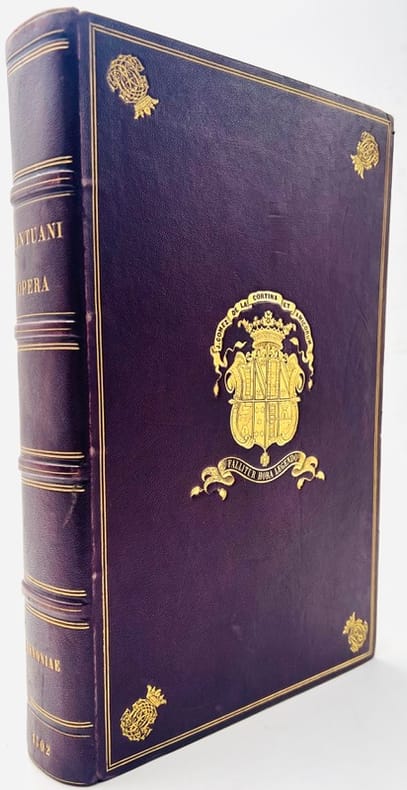
|
|
|
STILLWELL (Margaret Bingham) Editor.
Incunabula in American Libraries. A Second Census of Fifteenth-Century Books Owned in the United States, Mexico, and Canada.
4to, xlv,619pp., inner hinges shaken, orig. cloth.
|
|
|
SUDHOFF (Karl)
Deutsche Medizinische Inkunabeln. Bibliographisch-Literarisch Untersuchungen. Studien zur Geschiche der Medizin.
xxiv,278pp., illustrs., orig. cloth. Gives full descriptions for 464 books of the period.
|
|
|
SUETONIUS, Tranquillus / SIMONEN BELIVACQUA
De Vita XII Caesarum
Feuille d'incunable vénitien du quinzième siècle provenant de « De Vita XII Caesarum ». Venetiis, Simonen Belivacqua, 1496. Un feuillet in-folio (31.2 x 21.2 cm). Texte latin en caractères romains de 2 pages avec une lettrine non colorée. Tiré de « Vita Caesaris Augusti » (folio u iiii) Bel état. Brunet VI, 581. Graesse VI, 520.
Référence libraire : 3373
|
|
|
SÜLEYMAN IZZÎ, (?-1168/1755).
[THE 20TH ISLAMIC INCUNABULA] Târîh-i Izzî. [i.e. The chronicle of Izzî].
Very Good Turkish, Ottoman (1500-1928) Original dark brown handsome full leather bdg. with a traditional flap. Folio. (32 x 22 cm). In Ottoman script (Old Turkish with Arabic letters). [9], 288 leaves. The size of the text block in red borders: 25 x 14.5 cm. 33 lines on each page. Printed on paper with European watermarks. Handwritten title on bottom edge. Marginal cutting on the first page. Overall a very good copy. The 20th incunable of the Islamic world, printed by Ibrahim Müteferrika's legendary Basmahane. Süleymân Izzî succeeded Mehmed Subhî Efendi (ca. 1711 - 1769) in 1745 as an official court historian (vaka'nüvis) and held this office until 1753, and is known as one of the three chroniclers for coherent historiography, representing the events in the Ottoman history from 1730 to 1744 and is a particularly valuable source on the Habsburg-Ottoman War between 1736 and 1739, as proven by his chronicle titled "Tevârîh-i Sâmî ve Sâkir ve Subhî", published in 1784. During this time, he recorded the contemporary events taking place between 1744 and 1753 in the Ottoman Empire. This work was the last item in a series of chronicles published by the printing house founded by Müteferrika. Franz Babinger writes that some parts of the book have been translated into German. Hammer translated one of the parts in question into German. All published, Izzi has planned the third part of his work, but this third part was never published. Contents: "Ahd-i Hümâyûn".; "Zikr-i iâde-i fenn-i tiba'at" [i.e. On the book pressing and publishing with a preface by Ahmed Vâsif Efendi].; "Fihrist-i Târîh-i Izzî" [i.e. Content of Izzi's history].; Izzî tarihinin birinci bölümü [i.e. The first chapter].; Izzî tarihinin ikinci bölümü [The second chapter]. The workshop of Müteferrika began its historical mission in 1728. They published 17 works in 22 volumes. The printing house served as a means to the long-term goal of Müteferrika, his efforts to broaden the horizon and modernize the knowledge of Ottoman society and Islamic civilization. This is evidenced by the subjects of the books selected for publishing, the motivations put forth in the publisher's introductions, as well as by the documents illuminating the background of the publication of each book, also published in print. In 1742, with the publication of the Persian dictionary of Hasan Suûrî, a chapter of Ottoman book printing came to an end. With the death of Müteferrika, the printing of Turkish books was temporarily interrupted. The first generation of Ottoman-Turkish prints was soon followed by a new series, when in 1756 Ahmed and Ibrâhîm Efendi (the latter perhaps the founder's son, according to speculative sources) made an attempt to resurrect the legacy of Müteferrika through the possession of a decree obtained from the Sultan. However, this experiment did not prove to be lasting, as it did not last longer than the new edition of the first Turkish printed book, the Lugat-i Vankûlî. After this for several decades there was no continuation to the Turkish book printing established by Müteferrika, until in 1783 the workshop was put in operation again for the publication of six more works. The subjects of these late 18th century works were dominated by history and military technology, thus Müteferrika's strategy of book distribution made its way hand in hand with the efforts of modernization of the Ottoman state. The second edition of Lugat-i Vankûlî followed the principles of the first edition, and its introduction was composed on the model of the introductory pages of the two last books published under Müteferrika's supervision. The works published after 1783 display a noticeable development in typography not only as to its somewhat refined visual impression, but also in its structure. For example, the d+h and r+h ligatures, characteristic of the first generation of Müteferrika's printed books, are replaced by separate letters. This extremely rare presented book is from the seven publications of this late period of the
|
|
|
TEDESCHI (Niccolò), DIAZ DE MONTALVO (Alonso), CAMPIS (Ludovico, éditeur), SIBER (Johannes, imprimeur)
Repertorium quaestionum super Nicolaum de Tudeschis.
Lyon : Johann Siber, circa 1488. Folio (2°, 41x35cm), 162 feuillets (168), a-b6-c8-d6.e8-t8.v10.x9. 2 colonnes, 4 colonnes de table, 72 lignes, type 4:120G pour les chapitres, type 5:87G pour le texte Sans reliure, manque les 4 premiers feuillets, 1er feuillet sali (a6), dernier feuillet (x9) avec manque d’un tiers dont la marque de Johannes Siber, trous de vers, pages cornées, vieilles mouillures, manque de matière sur 5 feuillets en marge intérieure sans atteinte, tache feuillet v7. Impression en caractères gothiques sur deux colonnes ; les premières lettres de chaque chapitre sont colorisée (rouge ou bleu), annotations et maniques manuscrites en marge.
Référence libraire : PHO-1970
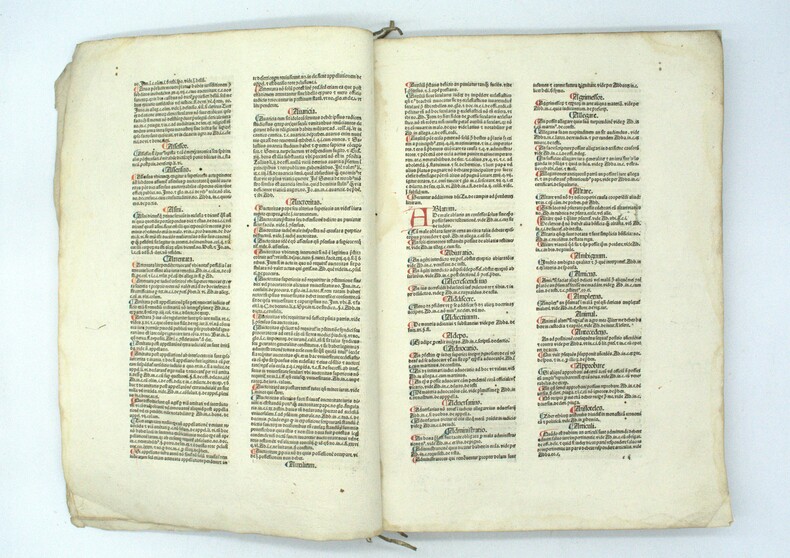
|
|
|
THOMAS A KEMPIS.
[Imitation de Jésus-Christ. Paris, 1491]. Gerson De imitatione Christi. Et de meditatione cordis.
Paris, Enguilbert I, Jean I et Geoffroy I de Marnef (impr Philippe Pigouchet), 1491. In-8 gothique (143 x 100 mm) de (96) ff. (sig. a-m8), maroquin brun, dos à 5 nerfs, quadruple filet d'encadrement et fleurons aux angles à froid sur les plats, tranches dorées (reliure du XIXe siècle).
Référence libraire : 15691
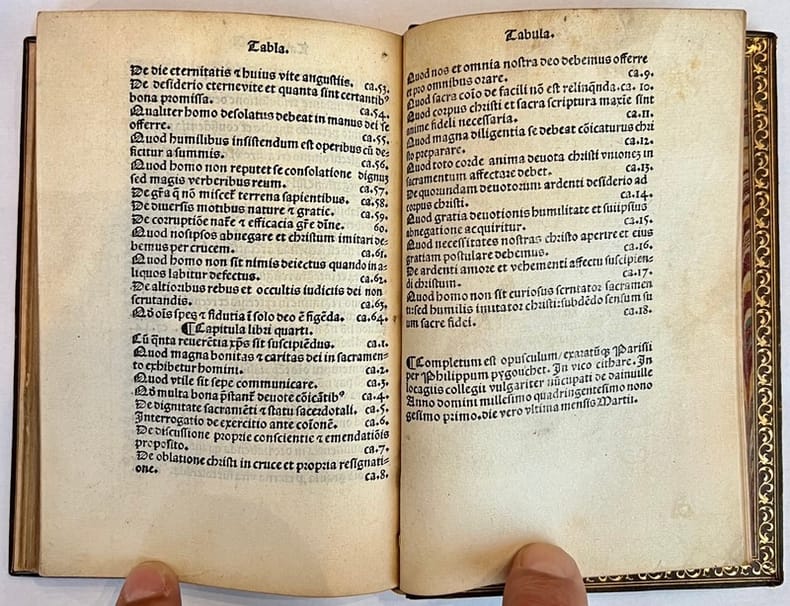
|
|
|
THOMAS (S) DE AQUINO (TOMMASO D'AQUINO TOMMASO SANTO)
(Catena Aurea) Opus Aureum Sancti Thome De Aquino Super Quatuor Evangelia.
[Incunabolo] (cm. 33) mz. pelle d' epoca, 3 nervi e assicelle in legno. Dorso con difetti, un piatto rimesso in epoca successiva.-- carte 310 numerate (di 313) + carte 5 non numerate. Caratteri gotici di differenti grandezze, due colonne, 66 linee. Bei capolettera ornati e figurati grandi e piccoli a fondo nero. Uno particolarmente bello a carta 239. Incunabolo molto bello e importante per il prezioso commento ai quattro vangeli scritto dal 1261 in poi dal grande aquinate, filosofo e dottore ufficiale della chiesa cattolica. L' ultima carta (oo6) contiene il colophon, il registro e la bella marca tipografica a fondo nero dello Scoto per la quale vedi Kristeller n° 281. Incunabolo particolarmente raro. Secondo Goff nessun esemplare in America, manca a Polain, Harvard, Cat. Harper (1930) e al grande Cat. 24 di rosenthal che nel 1900 mette in vendita a Monaco ben 3500 incunaboli. Purtroppo mancano solo 3 carte iniziali numerate 1,3 e 4 con segnatura a1, a3, a4. Le ultime sei hanno lievi macchie e aloni sempre ai margini. Le prime carte presenti, numerate 2,5,6,7,8 sono staccate e difettose, la n° 2 ha un buco con perdita di testo, meritano di essere restaurate. Tutto il resto del volume da carta 9 segnata b1 a carta 313 segnata oo è in esemplare veramente bello nitido fresco e marginoso. Il verso dell' ultima carta è bianco e porta un ex libris manoscritto dell' epoca: "ad usum fratris Raphaelis de Urbino...ipse liber". * Hain 1336; * I.g.i. 9519; * Proctor 5043; * Oates 1669; * Pellechet 909; * Olschki "Monumenta" 891; * Olschki " Inc. Typ." 23; * Walters "Inc. Typ." p. 32; * Bmc V 441.[f80] Libro
|
|
|
Thomas von Aquin (Aquinus; Tommaso d'Aquino; Thomae Aquinatis)
Catena aurea.
Venedig, Bonetus Locatellus für Octavianus Scotus, 4. Juni 1493. Fol. Mit großer Metallschnitt-Druckermarke am Schluss u. einigen meist schwarzgrundigen Holzschn.-Initialen. 313 num., 5 nn. Bll. (2 Kol., 66 Z., Got. Typ.), HPgmt. d. 19. Jhds. m. marmor. Deckeln u. Schnitt.
Référence libraire : 65208

|
|
|
TITUS LIVIUS / PHILIPPUS PINCIUS
Decades
Feuille d'incunable vénitien du quinzième siècle provenant de « Decades ». Venetiis, a Phil. Pincius, 1495. Un feuillet in-folio (31.6 x 21.8 cm). Texte latin en caractères ronds de 2 pages de 60 lignes. Tiré de « Liber Sextus Quartae Decadis » (folio CCXVI). Mouillures marginales, autrement bel état. Brunet III, 1103. Graesse IV, 226.
Référence libraire : 3374
|
|
|
TROEYER (Benjamin) & MEES (Leonide)
Bib-bibliographia Franciscana Neerlandica ante saeculum XVI.
2 Parts in 3 vols., text volumes in 8vo, plate volume 4to, 270; 184; 223pp., 510 facsimiles, presentation copy, orig. cloth. The first volume is made up in chronological order, containing the biographies of the Franciscan (Friars Minor) authors from the Netherlands and Belgium who lived during the 13th-15th centuries. The second contains extensive bibliographical descriptions of 131 fifteenth century editions of works by Franciscan authors. The typographical atlas provides 510 facsimiles taken from the 131 books described in the preceding volumes.
|
|
|
TURNBULL (Edward)
The Reference Library of the late Edward Turnbull. Founder of the Walpole Galleries. Incunabula, Early English Literature, Americana, The Fine Arts.
8vo, 287, [1]pp., Lathrop C. Harper's copy with a A.L.s from the librarian (Lawrence C. Wroth) of John Carter Brown Library asking Harper to bid on several lots on their behalf, prices and codes added to about half the lots in Harper's hand, orig. printed wrappers, a little worn, 2037 lots.
|
|
|
VENETIAN FRANCISCAN INCUNABLE BIBLIA LATINA.
Biblia Latina correcta per Angelum de Monte Ulmi with table of Gabriele Bruno
Venice: Hieronymus de Paganinis 1492. Hardcover. Very Good. 7 September 1492 from colophon: �Impressa vero in felici Venetorum ciuitate sumptibus et arte Hieronymi de Paganinis Brixiensis. Anno gratie millesimo quadrigentesimo nonagesimosecundo. Septimus Idus septembris.�. 8vo 170 x 120mm. 510 leaves of 552 lacking the Interpretation of Hebrew Names 41 leaves at the end and final blank. Signatures: A10 a-z8 aa-zz8 A-P8 Q12. Title printed with �Biblia� in gothic letter in upper margin above rectangular woodcut of St. Peter holding keys within double ruled border captioned �Tu es petrus� later hand coloring to halo and garb of Peter. Title verso with the �Tabula alphabetica historiarum Bibliae� compiled by Gabriele Bruno. Text printed double column index in triple column 50 lines to a full column printed in gothic type with red rubrics and headings rubricated versal initials alternating red and blue ink printed marginal citations throughout. Modern vellum yapped edges endpapers renewed; register and first few leaves of prologue little frayed to the margins some light dampstaining near end only light intermittent stains edges lightly browned annotations trimmed close in few margins and few minor marginal repairs otherwise a sound and solid incunable edition of the Biblia Latina retaining the inaugural woodcut. Scattered period Latin annotations and manicules in margins occasionally repeating a word in Scripture like �Patientia� or names of the biblical persons from text �Helias� �Jezebel� or �Joab� and names of kings and their sons are also curiously given much attention writing in more lengthy memory devices for their relationships �Roboam filius Salamonis rex in Juda� � all seemingly the work of one scholar and another cancelled early inscription on A9 perhaps the name �Carolii�. Overall studied and plenty in inscriptions some annotations in Jerome�s prologue and later books are written in red ink. This is the second octavo edition of the Latin Bible printed in Venice in 1492 containing the corrections by the Franciscan scholar Pierangelo da Montolmo named in the robust colophon as �Petrus Angelus de Monte Ulmi�; supposedly a folio edition was issued this same year by the same printer Girolamo de� Paganini or �Hieronymus de Paganinis� though not found in standard references. The earliest octavo edition of the Latin Bible also known as the �poor man�s Bible� was printed in Basel by Froben in 1491. This Venetian octavo edition is the first Latin Bible to include the �Tabula alphabetica historiarum Bibliae� an alphabetical table of contents compiled by the Franciscan Gabriele Bruno or Brunus in 1489. It is also the earliest printed Bible to display a woodcut on the title � printers of Bibles had previously avoided title pages to best imitate manuscript sources. This 1492 edition was reprinted in 1497 and corresponded closely to the Brescian edition of 1496; the more common 1497 reprint reused the St. Peter woodcut but omitted �Biblia� on the title page. The woodcut�s caption �Tu es Petrus� You are Peter is the formula spoken at papal coronations and the words have long been associated with arguments for papal authority. Interestingly Pope Alexander VI was ordained into the papal office the month prior to this printing on 11 August 1492. Corrected editions of the Bible abounded during the Renaissance a period of intense and progressive scholarship and increasing publishing opportunities; this edition is distinctly associated with Franciscan study and use and made revolutionary efforts to organize the Bible with Bruno�s new contents list. The new �pocket-sized� Bible was an easier and more affordable format to disseminate Scripture. Travelling clergy would have especially benefitted from its portability. This copy interesting for its somewhat heavy Latin marginalia dating closely to the period of the printing; the eager reader names biblical persons of interest and contemplates their genealogical relationships throughout. ISTC 594000. <br/><br/> Hieronymus de Paganinis hardcover
Référence libraire : D16270
|
|
|
VENETIAN FRANCISCAN INCUNABLE BIBLIA LATINA.
Biblia Latina correcta per Angelum de Monte Ulmi with table of Gabriele Bruno
Venice: Hieronymus de Paganinis 1492. Hardcover. Very Good. 7 September 1492 from colophon: “Impressa vero in felici Venetorum ciuitate sumptibus et arte Hieronymi de Paganinis Brixiensis. Anno gratie millesimo quadrigentesimo nonagesimosecundo. Septimus Idus septembris.”. 8vo 170 x 120mm. 510 leaves of 552 lacking the Interpretation of Hebrew Names 41 leaves at the end and final blank. Signatures: A10 a-z8 aa-zz8 A-P8 Q12. Title printed with “Biblia” in gothic letter in upper margin above rectangular woodcut of St. Peter holding keys within double ruled border captioned “Tu es petrus” later hand coloring to halo and garb of Peter. Title verso with the “Tabula alphabetica historiarum Bibliae” compiled by Gabriele Bruno. Text printed double column index in triple column 50 lines to a full column printed in gothic type with red rubrics and headings rubricated versal initials alternating red and blue ink printed marginal citations throughout. Modern vellum yapped edges endpapers renewed; register and first few leaves of prologue little frayed to the margins some light dampstaining near end only light intermittent stains edges lightly browned annotations trimmed close in few margins and few minor marginal repairs otherwise a sound and solid incunable edition of the Biblia Latina retaining the inaugural woodcut. Scattered period Latin annotations and manicules in margins occasionally repeating a word in Scripture like “Patientia” or names of the biblical persons from text “Helias” “Jezebel” or “Joab” and names of kings and their sons are also curiously given much attention writing in more lengthy memory devices for their relationships “Roboam filius Salamonis rex in Juda” – all seemingly the work of one scholar and another cancelled early inscription on A9 perhaps the name “Carolii”. Overall studied and plenty in inscriptions some annotations in Jerome’s prologue and later books are written in red <br />ink. This is the second octavo edition of the Latin Bible printed in Venice in 1492 containing the corrections by the Franciscan scholar Pierangelo da Montolmo named in the robust colophon as “Petrus Angelus de Monte Ulmi”; supposedly a folio edition was issued this <br />same year by the same printer Girolamo de’ Paganini or “Hieronymus de Paganinis” though not found in standard references. The earliest octavo edition of the Latin Bible also known as the “poor man’s Bible” was printed in Basel by Froben in 1491. This Venetian octavo <br />edition is the first Latin Bible to include the “Tabula alphabetica historiarum Bibliae” an alphabetical table of contents compiled by the Franciscan Gabriele Bruno or Brunus in 1489. It is also the earliest printed Bible to display a woodcut on the title – printers of <br />Bibles had previously avoided title pages to best imitate manuscript sources. This 1492 edition was reprinted in 1497 and corresponded closely to the Brescian edition of 1496; the more common 1497 reprint reused the St. Peter woodcut but omitted “Biblia” on the title page. The woodcut’s caption “Tu es Petrus” You are Peter is the formula spoken at papal coronations and the words have long been associated with arguments for papal authority. Interestingly Pope Alexander VI was ordained into the papal office the month prior to this printing on 11 August 1492. Corrected editions of the Bible abounded during the Renaissance a period of intense and progressive scholarship and increasing publishing opportunities; this edition is distinctly associated with Franciscan study and use and made revolutionary efforts to organize the Bible with Bruno’s new contents list. The new “pocket-sized” Bible was an easier and more affordable format to disseminate Scripture. Travelling clergy would have especially benefitted from its portability. This copy interesting for its somewhat heavy Latin marginalia dating closely to the period of the printing; the eager reader names biblical persons of interest and contemplates their genealogical relationships throughout. ISTC 594000. <br/><br/> Hieronymus de Paganinis hardcover books
Référence libraire : D16270
|
|
|
VENZKE (Andreas)
Johannes Gutenberg: Der Erfinder des Buchdrucks.
370pp., coloured illustrs., orig. cloth, d.w.
|
|
|
VESPERAL ROMAIN
Le Vesperal romain a l'usage du diocèse de Quebec
Québec Chez John Neilson, imprimeur libraire 1802
Référence libraire : 28475
|
|
|
Vindel, Francisco
El arte tipografico en Espana durante el siglo XV. Sevilla y Granada.
Reprint of this classic bibliography of Andalusian incunabula. Originally published as a volume in Vindel's comprehensive survey of 15th-century printing in Spain, this volume was reprinted in a limited edition of 2000 copies as part of the celebration of the 500th anniversary of the discovery of the New World. Over 150 items described with numerous facsimiles for each item, many full-page and many printed in red and black. A beautiful production, printed on laid paper and bound in decorated imitation vellum. Large folio, LII + 440 pages.
|
|
|
Voragine, Jacobus de:
Legenda Aurea Sanctorum. Lombardica historia que a plerisque Aurea Legenda factorum appellatur.
Argentinae (Strassburg, Georg Husner), August 16, 1490, In folio (28,5x19.5 cm) 14 leaves (including title page with printed title & a hw. cont. inscription of 4 lines, verso with 7 lines of music) + 245 leaves (without last blank), Rubricated throughout, some waterstains in the beginning - some marginal hw. remarks - music on title-verso early 17th c.: Surrexit Christus hodie Alleluia/ Humano pro solamine. Est attesté dès le 14e s. Il s’agit d’un canon ad repetendum à cinq voix avec cinq voix avec basse continue, le tenor commence et la fin est écrite. Musique d’un auteur inconnu, pièce dans le style de Scheidt, Buxtehude, probablement du début 17e s. Contemporary full sheep-skin over wooden boards. Tooled front, free flyleaves renewed. (First binding, rubbed and traces of its 525 years of existence).
Référence libraire : 117943aaf
|
|
|
VORAGINE (Jacopo da Varazze ou da Varagine, dit Jacques de)
Legenda sanctorum sive Lombardica hystoria.
Fort volume in-4 (230 x 170 mm), demi-peau de truie estampée à froid sur ais de bois, dos gothique à trois double-nerfs orné de compartiments cloisonnés et fleuronnés à froid d'un grand fer à motif de rose, plats cloisonnés ornés de fers à motifs de chien, aigle à deux têtes couronné, cerf, lion, fleur de lys, bouquet et rose héraldique, lanière de cuir partielle, titre inscrit à l'encre sur la tranche de tête (reliure allemande de l'époque), grande initiale puzzle au premier feuillet et initiales rubriquées sur l'ensemble du volume ; CCLXXIII feuillets, (3) p. de tables, texte imprimé sur deux colonnes. Nuremberg, Georg Stuchs de Sulczpach, 1 octobre 1488
Référence libraire : 39206

|
|
|
VOULLI?ME (Prof. Dr. E.)
Die Deutschen Drucker des F?nfzehnten Jahrhunderts... Zweite Auflage.
4to, facsimiles throughout, cont. quarter morocco, slightly rubbed, uncut.
|
|
|
WEGENER (Johannes)
Die Zainer in Ulm. Ein Beitrag zur Geschichte des Buchdrucks im XV. Jahrhundert.
First Edition, 4to, [viii],70,[2]pp., with the H.P. Kraus bookplate, orig. boards, slightly faded, leather label on spine.
|
|
|
WEHMER (Carl)
Zur Beurteilung des Methodenstreits in der Inkunabelkunde.
4to, 77pp., facsimiles in the text, orig. printed wrappers, torn.
|
|
|
WOUDE (S. van der) Editor.
Studia Bibliographia in Honorem Herman de la Fontaine Verwey. A Collection of Studies and Essays in Bibliography and Allied Subjects.
First Edition, 478,[2]pp., frontis., numerous plates, orig. cloth, d.w. The book contains 28 contributions of which 13 in English, 13 in French, and 2 in German.
|
|
|
WYNKYN DE WORDE.
Lady Margaret Beaufort, Countess of Richmond (Mother of King Henry VII). Elizabeth of York (Queen of King Henry VII) and Wynkyn de Worde. A Copy of Walter Hylton's 'Scala perfectionis', Printed by Wynkyn de Worde in 1494 at the Special Command of Lady Margaret, with Presentation Inscription by her and by the Queen. A Description by P.J. Croft.
4to, 12pp., 6 plates, orig. printed wrappers.
|
|
|
WYNKYN DE WORDE.
Sermo die lune in ebdomada Pasche by Richard Fitz-James. Printed at Westminster by Wynkyn de Worde about the year 1495.
4to (270 x 180mm), [6]pp., with introduction followed by 40 ff. in exact facsimile, one of 250 copies, a very good ex-library copy, orig. vellum-backed boards, vellum label on upper cover, uncut.
|
|
|
WYNKYN DE WORDE.
The abbaye of the holy ghost. Printed at Westminster by Wynkyn de Worde about the year 1496.
Small 4to (265 x 180 mm), [vi]pp., + 38 pages of facsimiles, limited to 250 copies, a very good ex-library copy, vellum-backed boards, slightly rubbed, vellum label on upper cover, uncut.
|
|
|
WYNKYN DE WORDE.
The Frere and the Boye. Printed at London in Fleet Street by Wynkyn de Worde about the Year 1512.
4to (270 x 180mm), [6]pp., with introduction followed by 8 ff. in exact facsimile, one of 250 copies, orig. vellum-backed boards, vellum label on upper cover, uncut.
|
|
|
WYNKYN DE WORDE.
The Frere and the Boye. Printed at London in Fleet Street by Wynkyn de Worde about the Year 1512.
4to (270 x 180mm), [6]pp., with introduction followed by 8 ff. in exact facsimile, one of 250 copies, ex-library, orig. vellum-backed boards, vellum label on upper cover, uncut.
|
|
|